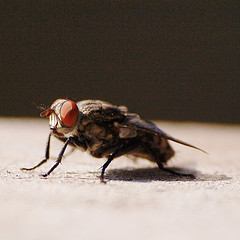House Flies Could Be From a Dead Animal
By Chris Williams on July 7, 2015.

Common Housefly – Musca Domestica
We have house flies inside our house all the time. I find them in almost every room at the windows. This has been going on for about a month. They’re not those metallic blue blow flies. They look like regular house flies. Our garbage can is clean and has a lid and we don’t have any pets, so no pet poop anywhere. Where are they coming from? S. M., Barrington, NH
Are They Really House Flies?
The first thing is to make sure that the flies really are house flies. There are a couple of other flies that look very similar and can sometimes be found in homes as well. Cluster flies show up in homes in spring after spending the winter inside, usually in attics (see Cluster Flies Have Been in Your House All Winter!). They look somewhat like house flies, but are larger and without stripes on their backs. Cluster flies are regional problems and you usually know if you have them since they reoccur indoors year after year. Cluster fly larvae feed outside on earthworms. There are also blow flies that are drab gray like house flies and not metallic colored. Their habits, though, are similar to house flies and control would be the same.
If the flies are house flies or blow flies, the next step is to find out what the fly larvae are feeding on. I think we can rule out that the flies are coming in daily from outside…unless you live next to a pig farm or have an elephant using your yard for a bathroom. That leaves something inside your home that is feeding fly larvae and I hate to tell you the kinds of things fly larvae feed on (see Sources for House Flies Inside a Home).
Have You Noticed a Bad Odor?
This would be our next question. Assuming garbage management is not a problem, the next best guess is an animal carcass somewhere in your wall voids, attic, or some other unfrequented or inaccessible part of your home. When a rat, squirrel, bird, or other animal dies, it doesn’t take long for a blow fly or house fly to zero in on the carcass where she proceeds to lay eggs. The eggs hatch and the larvae develop very quickly as they feed on the rotting flesh. The full-grown larvae pupate and shortly after, adult flies emerge.
Even though the carcass may be in an inaccessible place, the adult flies have no trouble finding their way out into living spaces, sometimes by the hundreds.
Your first step should be to contact Colonial Pest. Our trained technicians can identify the flies and hopefully can locate their food source. If it’s a dead animal, we will try to find the carcass and remove it. We will also set you up with an odor control program if necessary, and we can definitely control the emerging flies no matter what the source. Give us a call.